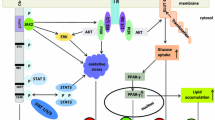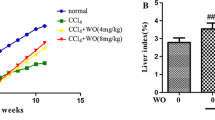Abstract
This study was designed to investigate the prophylactic effects and the mechanisms of curcumin on liver fibrosis in rats. Liver fibrosis was induced in 72 Sprague Dawley rats by intraperitoneal injection of carbon tetrachloride. Rats were divided into control, liver fibrosis, high, medium, and low dose curcumin (200, 100, and 50 mg kg−1, respectively), and colchicine (0.1 mg kg−1) groups. After 8 weeks of treatment, histopathological examination was performed on hepatic tissues, and liver fibrosis was graded. Hepatic stellate cells activity was examined by smooth muscle alpha-actin immunohistochemistry staining, and apoptosis was detected by terminal deoxynucleotidyl transferase dUTP nick-end labeling. The liver fibrosis score in the high, medium, and low dose curcumin group (5.79 ± 1.80, 8.58 ± 3.34, and 9.58 ± 3.32, respectively) and the colchicine group (4.91 ± 1.28) was significantly lower than in the fibrosis group (20.40 ± 3.38, P < 0.01). The ratio of activated hepatic stellate cells in the three curcumin groups (0.97 ± 0.69, 2.06 ± 0.58, and 3.49 ± 1.03, respectively) and the colchicine group (0.78 ± 0.31) was significantly lower than in the fibrosis group (6.08 ± 1.13, P < 0.05). The apoptosis index in the three curcumin groups (0.57 ± 0.21, 0.37 ± 0.22, and 0.34 ± 0.21, respectively) was higher than in the fibrosis (0.09 ± 0.09, P < 0.05) or the colchicine group (0.16 ± 0.19, P < 0.05). Curcumin prevents carbon tetrachloride-induced liver fibrosis in rats. The prevention of liver fibrosis may be due to the inhibition of the activation of hepatic stellate cells and induction of their apoptosis.




Similar content being viewed by others
References
Gressner AM (1998) The cell biology of liver fibrogenesis—an imbalance of proliferation, growth arrest and apoptosis of myofibroblasts. Cell Tissue Res 292:447–452
Adhikari S, Indira Priyadarsini K, Mukherjee T (2007) Physico-chemical studies on the evaluation of the antioxidant activity of herbal extracts and active principles of some Indian medicinal plants. J Clin Biochem Nutr 40:174–183
Moragoda L, Jaszewski R, Majumdar AP (2001) Curcumin induced modulation of cell cycle and apoptosis in gastric and colon cancer cells. Anticancer Res 21(2A):873–878
Park EJ, Jeon CH, Ko G, Kim J, Sohn DH (2000) Protective effect of curcumin in rat liver injury induced by carbon tetrachloride. J Pharm Pharmacol 52:437–440
The French METAVIR Cooperative Study Group (1994) Intraobserver and interobserver variations in liver biopsy interpretation in patients with chronic hepatitis C. Hepatology 20(1 Pt 1):15–20
Brenner DA, Waterboer T, Choi SK, Lindquist JN, Stefanovic B, Burchardt E (2000) New aspects of hepatic fibrosis. J Hepatol 32:32–38
Gabele E, Brenner DA, Rippe RA (2003) Liver fibrosis: signals leading to the amplification of the fibrogenic hepatic stellate cell. Front Biosci 8:69–77
Friedman SL (2004) Mechanisms of disease: mechanisms of hepatic fibrosis and therapeutic implications. Nat Clin Pract Gastroenterol Hepatol 1:98–105
Xu J, Fu Y, Chen A (2003) Activation of peroxisome proliferator-activated receptor-gamma contributes to the inhibitory effects of curcumin on rat hepatic stellate cell growth. Am J Physiol Gastrointest Liver Physiol 1(285):G20–G30
Nikolaidis N, Kountouras J, Giouleme O, Tzarou V, Chatzizisi O, Patsiaoura K (2006) Colchicine treatment of liver fibrosis. Hepatogastroenterology 53:281–285
Muriel P, Moreno MG, Hernandez Mdel C, Chavez E, Alcantar LK (2005) Resolution of liver fibrosis in chronic CCl4 administration in the rat after discontinuation of treatment: effect of silymarin, silibinin, colchicine and trimethylcolchicinic acid. Basic Clini Pharmacol Toxicol 96:375–380
Clement MJ, Rathinasamy K, Adjadj E, Toma F, Curmi PA, Panda D (2008) Benomyl and colchicine synergistically inhibit cell proliferation and mitosis: evidence of distinct binding sites for these agents in tubulin. Biochemistry 47:13016–13025
Salai M, Segal E, Cohen I, Dudkiewicz I, Farzame N, Pitaru S, Savion N (2001) The inhibitory effects of colchicine on cell proliferation and mineralisation in culture. J Bone Joint Surg 83:912–915
Kang HC, Nan JX, Park PH, Kim JY, Lee SH, Woo SW (2002) Curcumin inhibits collagen synthesis and hepatic stellate cell activation in vivo and in vitro. J Pharm Pharmacol 54:119–126
Mackenzie GG, Queisser N, Wolfson ML, Fraga CG, Adamo AM, Oteiza PI (2008) Curcumin induces cell-arrest and apoptosis in association with the inhibition of constitutively active NF-kappaB and STAT3 pathways in Hodgkin’s lymphoma cells. Int J Cancer 123:56–65
Son G, Iimuro Y, Seki E, Hirano T, Kaneda Y, Fujimoto J (2007) Selective inactivation of NF-kappaB in the liver using NF-kappaB decoy suppresses CCl4-induced liver injury and fibrosis. Am J Physiol Gastrointest Liver Physiol 293:G631–G639
Choudhuri T, Pal S, Agwarwal ML, Das T, Sa G (2002) Curcumin induces apoptosis in human breast cancer cells through p53-dependent Bax induction. FEBS Lett 512:334–340
Nanji AA, Jokelainen K, Tipoe GL, Rahemtulla A, Thomas P, Dannenberg AJ (2003) Curcumin prevents alcohol-induced liver disease in rats by inhibiting the expression of NF-kappa B-dependent genes. Am J Physiol Gastrointest Liver Physiol 284:321–327
Kamalakkannan N, Rukkumani R, Varma PS, Viswanathan P, Rajasekharan KN, Menon VP (2005) Comparative effects of curcumin and an analogue of curcumin in carbon tetrachloride-induced hepatotoxicity in rats. Basic Clin Pharmacol Toxicol 97:15–21
Acknowledgments
The authors wish to thank Drs Li Fang and Guan-Ying Xiao at the Department of Pathology, Guangzhou Red Cross Hospital, and Drs Xiao-HongYan and Yan Shen at Guangzhou Wound Research Institute for their technical support.
Author information
Authors and Affiliations
Corresponding author
Rights and permissions
About this article
Cite this article
Shu, JC., He, YJ., Lv, X. et al. Curcumin prevents liver fibrosis by inducing apoptosis and suppressing activation of hepatic stellate cells. J Nat Med 63, 415–420 (2009). https://doi.org/10.1007/s11418-009-0347-3
Received:
Accepted:
Published:
Issue Date:
DOI: https://doi.org/10.1007/s11418-009-0347-3




